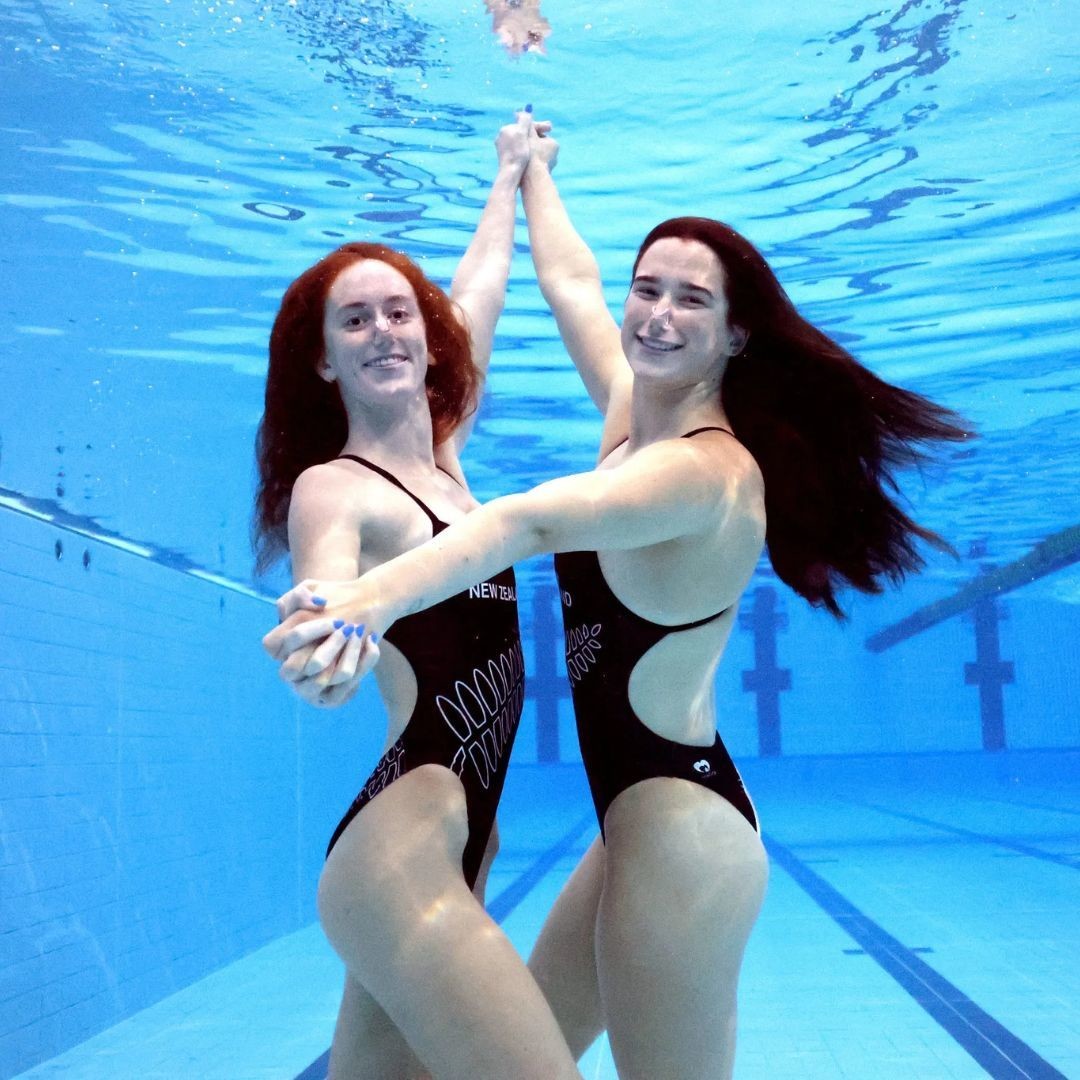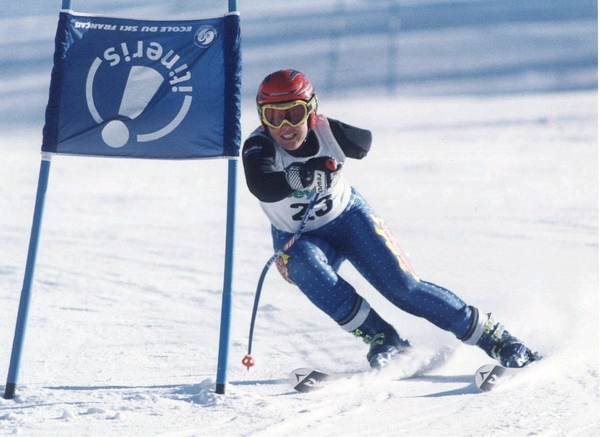5 4 3 2 1 Paris: Eva Morris and Nina Brown Treading water for years, artistic swimmers Eva Morris and Nina Brown have made it to their first Olympics, through a ton of guts, glitter and heartbreak, they tell Suzanne McFadden in the final part of our Olympic countdown series.


5 4 3 2 1 Paris: Eva Morris and Nina Brown
Treading water for years, artistic swimmers Eva Morris and Nina Brown have made it to their first Olympics, through a ton of guts, glitter and heartbreak, they tell Suzanne McFadden in the final part of our Olympic countdown series.
by Suzanne McFadden24/07/2024
LockerRoom in association with

For the past nine months, Eva Morris and Nina Brown have lived, and breathed, in synchronicity.
When the artistic swimmers became a duet late last year, Morris decided to leave her home in Tauranga and move into Brown’s apartment on the Gold Coast so they could train above and below the water together every day.
“Honestly, we are both pretty clumsy on land,” Brown laughs. “But at least we’re synchronised, clumsily, now we’re living together. Our whole lives are in sync.”
Yet the athletes were a world apart when they learned they were off to their first Olympics, in Paris.
Morris was on New York City’s Fifth Avenue, her phone propped up against a tower of men’s polo shirts in clothing store Uniqlo. “It was also a lot quieter than the women’s section to take the call,” she says.
“I knew I was getting the call, and I wasn’t being very nice to my mum for the hour beforehand because I was so nervous.”
The duo had been travelling the world for four months to prove to the New Zealand Olympic Committee they were capable of finishing in the top 16 in Paris. They’d wrapped up their final competition at the World Cup in Canada and were taking a break with their families, waiting to discover if they’d been selected.
But when she saw artistic swimming selector Jo Burns smiling on the video call back in New Zealand, Morris knew it had to be good news.
“I swore and cried a lot… I was just very relieved,” the 26-year-old says. “Then Mum proceeded to tell everyone in Uniqlo, ‘My daughter’s going to the Olympics!’, even though we were sworn to secrecy. But she figured she would never see them again.”
At the same moment, Brown was in Sydney visiting her parents. She was in bed asleep five minutes before she took the call.
“My dad woke me up with a very suspicious, ‘So where will you take this call?’ and I was immediately wide awake. I kicked everyone out of the room and took the call by myself, in bed,” says Brown, who’s 21.
“I was pretty stressed; I didn’t think we were going to get it. So I was just over the moon. I opened the door and was jumping and crying with my mum, but Dad thought it was bad news and started comforting me. He’s just supportive, no matter what. But I promptly corrected him that they were happy tears.”
After all the graft – training 30 hours a week, in and out of the pool – and the heartbreak of falling short in qualifying in the teams event for the past two Olympics, the call felt like a weight had been lifted from the pair’s shoulders. “Now there’s another weight: to perform well at the Olympics,” says Morris.
They’ve travelled quite different roads to reach their first Olympic Games in Paris.
Born to sparkle
Morris was a pupil at Pt Chevalier Primary in 2008, when her teacher, Karen Girsberger, assigned her a school project on sisters Nina and Lisa Daniels, who were competing in synchronised swimming – as it was known then – at the Beijing Games (the last Kiwi duet to do so).
Back then Morris was a netballer – her hero was Silver Fern Laura Langman – and knew nothing of synchro. But she became mesmerised by the sport, and is forever thankful to Girsberger, who was at the pool in Albany last month when Morris and Brown were named for Paris.
“It was really nice to share this special moment with her. It feels very full circle,” Morris says.
Artistic swimming completely hooked the 11-year-old, who started with Tauranga Synchro when her family moved to the Bay of Plenty.
“Initially, it was the sparkly togs because I’m kind of like a magpie – I’m drawn to the glitter,” she says. “But then also because it’s a real combination of sports – gymnastics, swimming and dance. I wasn’t so good at all of the sports that combine to make synchro but somehow managed to make it work.
“That’s the best part about synchro. You can have the artistic aspect, but it’s also incredibly physically demanding. And it’s in the water, which is a lot better than on the land to me.”
It’s been said that artistic swimming is the most demanding sport on the Olympic programme – requiring strength, endurance, flexibility, grace and precise timing. All done underwater.
“It’s really interesting, some people say it’s like running a 200m sprint, holding your breath, smiling, and then taking one breath, and doing that again, consistently for three minutes straight in sync with another person,” Morris says.
“And at an Olympics, you’re doing it with the world watching. So imagine doing that, and then probably times it by two, and that’s about how hard it is.
“The new rules make it incredibly hard. There’s a lot of time spent under the water and a lot of emphasis on doing everything as perfect as you can. So it’s a lot of mental pressure as well, not just physical, making sure that we can perform under pressure.”
Competing at an Olympics didn’t appear on Morris’ radar until 10 years ago.
“When people say they were five when they first wanted to go to the Olympics – that was not me. I first thought about it when I was asked in 2014 to join a New Zealand team trying to qualify for the Rio Games. So I made a big decision to leave school and join the team going to the 2015 world aquatics championships in Russia to try and qualify,” says Morris, who later captained the Aquaferns.
“We just missed out, which was pretty heartbreaking, and I’ve been trying ever since. So it’s so special to qualify, because a lot of athletes haven’t had this opportunity and I really feel for them.”
Underwater gymnastics
Brown, who grew up on Auckland’s North Shore, came from a ballet and gymnastics background.
“I was actually a national champion in rhythmic gymnastics back in the day,” she says. “But I was getting injured a lot though. My ankles and my knees weren’t so good, and my mum pulled me out.
“My brother was playing water polo at the time, and we’d go along to the Glenfield Pools and see the girls in the North Harbour Synchro Club training. Mum put me in, and because of my background in gymnastics and ballet, and my ability to swim, I was pretty naturally good.
“I started playing water polo and other sports. But eventually it all narrowed down to synchro.”
Brown also didn’t have Olympic ambitions until 2019, when she was part of the New Zealand team with Morris trying to qualify for the Tokyo 2020 Games. “Unfortunately that didn’t happen either, and all of us were quite heartbroken,” she says.
“After that I moved to Australia. I kept training and for a minute there, I thought about changing my citizenship and going for the Australia team. But that also fell through.
“I really thought that everything was telling me to just stop.”
But she eggbeater-kicked on, and after New Zealand secured an Olympic spot in Paris at the 2023 world aquatic champs, Brown and Morris were selected to work together as a duet in November, in a bid to meet the NZOC selection criteria.
Morris moved to the Gold Coast to train with Brown under their coach Marina Kholod, a former Ukrainian synchronised swimmer, who’s coached Australian Olympians. “She’s awesome. We’ve performed under pressure and managed to gain selection, which is a real testament to Marina,” Morris says.
This year, the duet put “a lot of blood, sweat, tears and money” into proving they were capable of finishing in the top 16 in Olympic competition.
They competed for the first time as a duet in February at the world championships in Doha, then went on to Malta, Hungary, Australia and Canada. At each competition, Kholod stepped up the difficulty in their routines; they steadily improved their execution and secured better scores.
So when they got that call – Brown in Sydney and Morris in NYC – confirming they were just the third New Zealand duet to compete at an Olympics, they were “over the moon”.
“It really shows that all the hard work and sacrifice we’ve put into the sport – especially in this past six months – is paying off, along with everything our parents and our sport have done for us behind the scenes,” Brown says.
“We just can’t wait to show them what it’s all been for and make them even more proud when we compete in Paris.”
Morris and Brown hope to be part of both the opening and closing ceremonies in Paris, as their competition isn’t until the final two days of the Olympics. They plan to catch a train from their training camp in Grenoble, then board a boat in the “floating” opening ceremony on the River Seine this Saturday (5.30am NZ time).
- Men are allowed to compete in artistic swimming teams for the first time at these Olympics, but no man has been selected among the 96 athletes from 18 nations, which has raised questions on the gender equality of these Games.










































































































































































